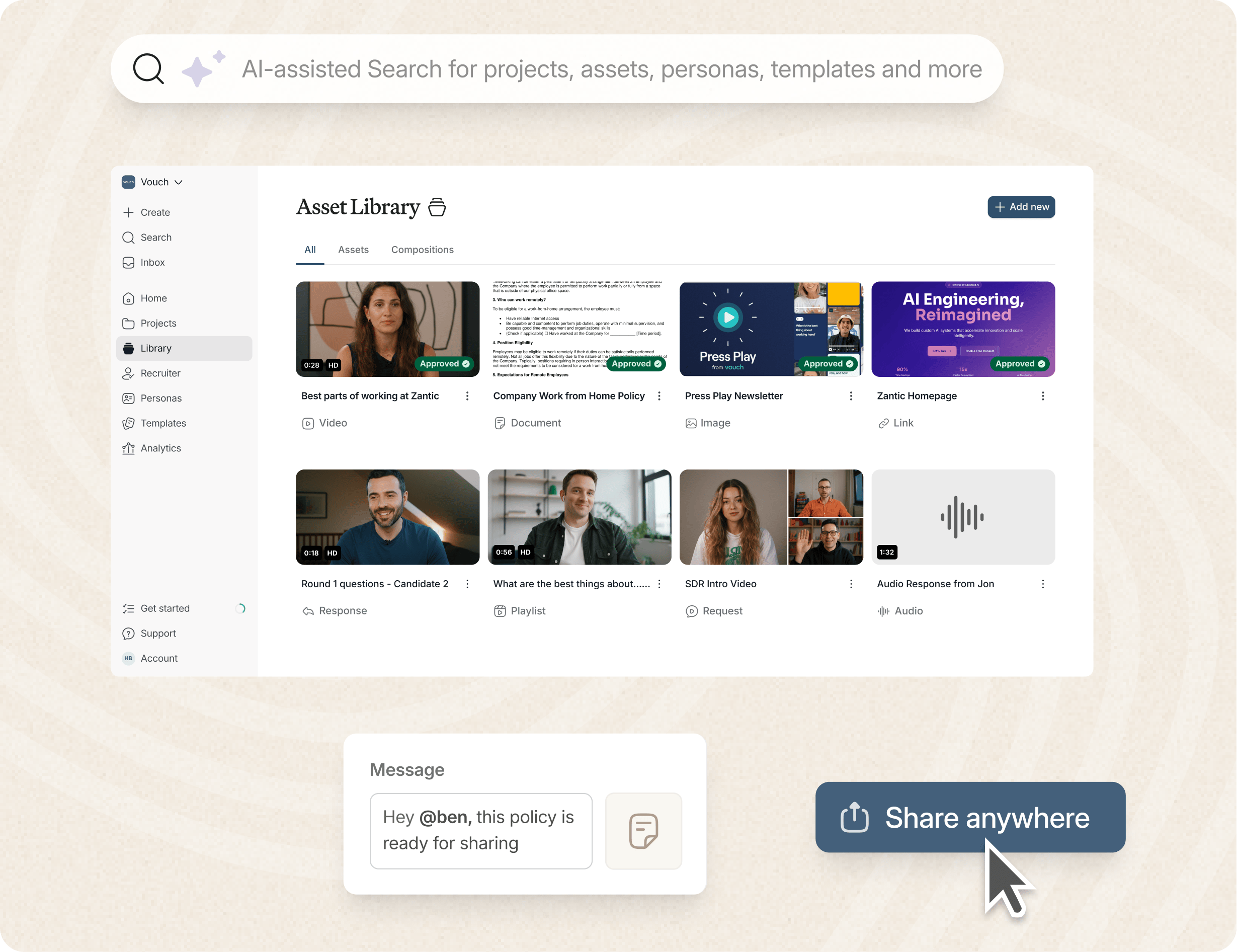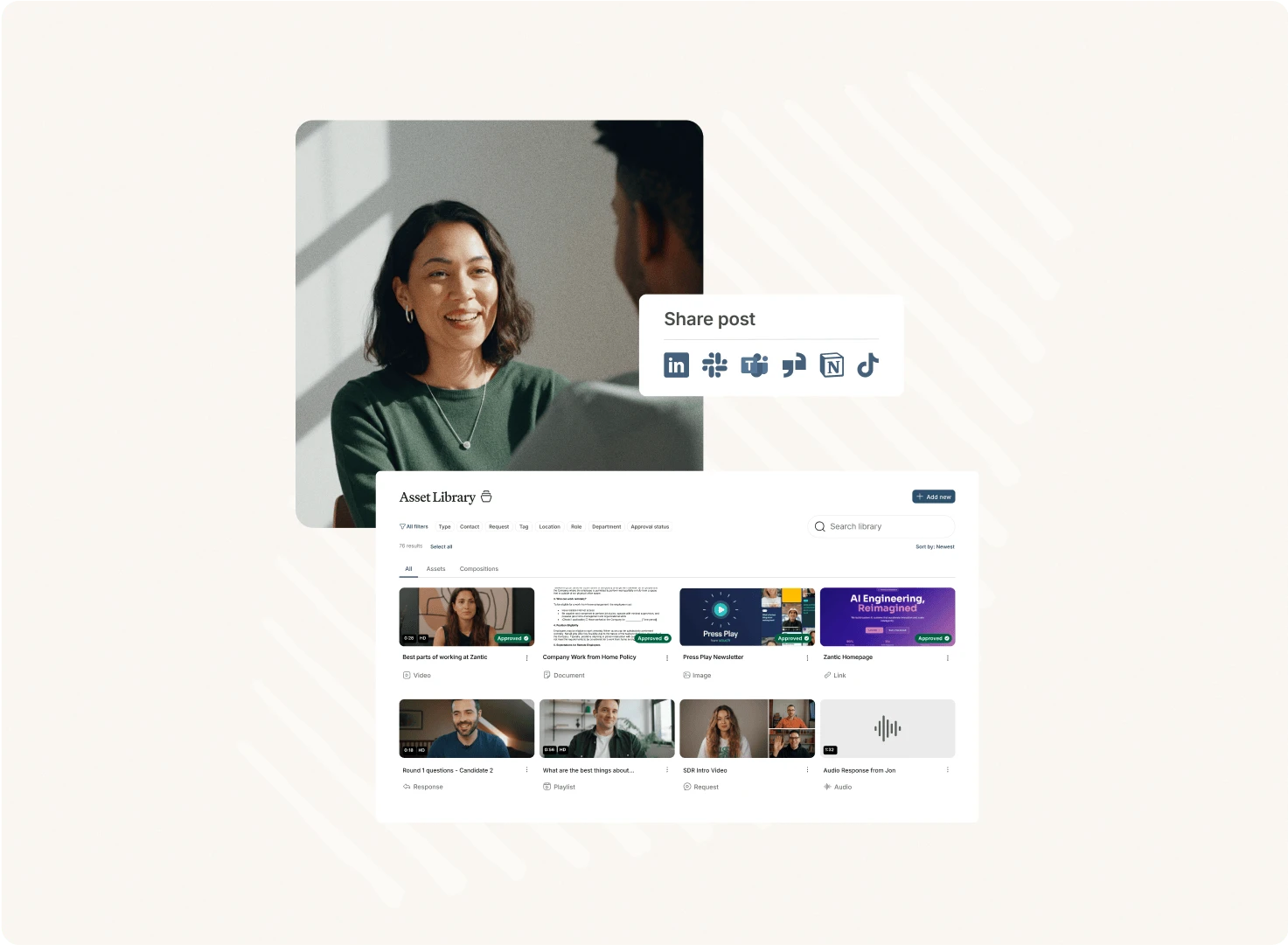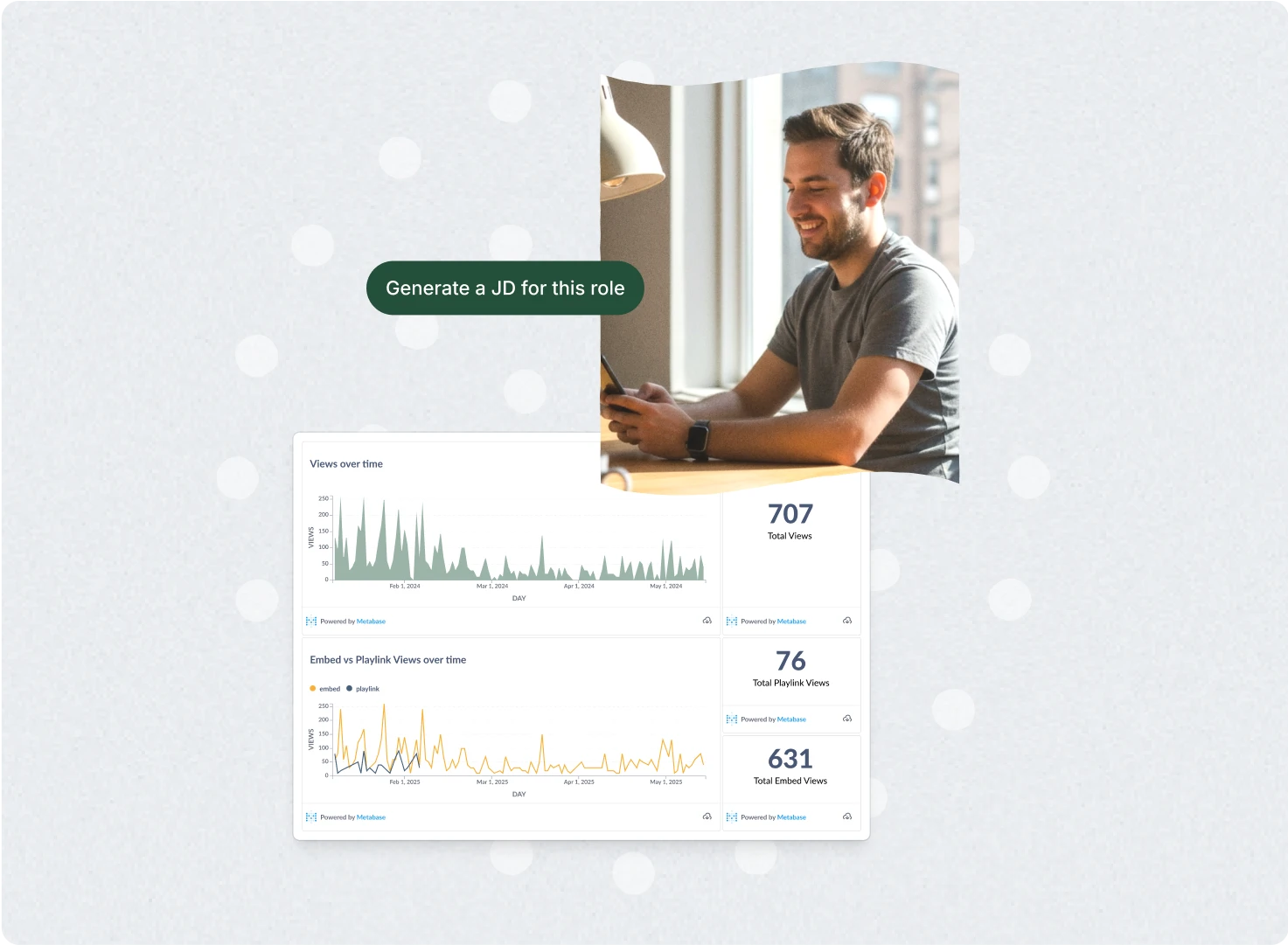In 2026, employee advocacy is a powerful marketing strategy that helps you promote your company through your employees' eyes.
With their unique insights and experiences, employees and customers are the best advocates for your company, especially on social media.
This strategy can help you quickly boost your brand's visibility, reach a wider audience, and build customer trust. Your employee advocacy and employee testimonials can also be quickly integrated with your company's current social media marketing strategies for Recruitment and Employer Branding growth.
But are you leveraging employee advoacy on socoial media?
By harnessing employee advocacy, you can increase your brand's strength and trust and reach a wider audience, and modern video tools like Vouch make employee advocacy on social media a lot easier.
So let's get started!
Why Does Employee Advocacy Matter?
Like customer experiences, employee advocacy empowers workers to amplify company news and programs, share positive experiences, open job positions and even recommend your products or services to others.
When your employees promote your brand, they become valuable assets with personal experiences that can resonate with your target audience. This is especially true when it comes to building your Employer Brand and attracting top talent at the top of your recruitment funnel.
Adding your employee advocacy video to your social media mix allows you to tap into the power of authentic and genuine content rather than relying solely on corporate messaging and marketing. With a successful program, you can essentially humanize your brand and connect with your audience on a more personal level.
Here are 5 employee advocacy statistics that matter:
When looking online, there are some statistics that really stand out, including these:
- 92% of B2B buyers trust employee recommendations over traditional advertising, underscoring the unrivalled trust employees create
- Employee posts achieve up to 561% more reach than those shared by brands
- Leads from employee-shared content convert at a rate 7× higher than other content types
- 83% of employees feel more engaged when their company encourages advocacy
- Employees in advocacy programs are 3.7× more likely to stay with their employer
Why Use Employee Advocacy In Your Digital Marketing?
By leveraging employee advocacy as an integral part of your digital marketing strategy, you can harness the power of your real storytelling with the following benefits:
1) Enhance Your Brand's Credibility
Brand credibility goes a long way when it comes to employee advocacy on social media. Customers tend to trust recommendations from customers and employees, rather than traditional advertising with models. When your workers share their experiences, recommendations, or any company good news, it adds credibility to your brand and increases the likelihood of conversions.
2) Amplify Your Brand Reach
When your employees advocate for your brand on social media, their networks extend your brand's reach. By leveraging their connections, you can expand your brand's visibility and reach a wider audience.
3) Drives Employee Engagement
Employee advocacy programs can boost workers' morale and engagement by empowering them to promote the company actively. They would feel valued and connected to the brand and are more likely to be passionate about their work.
4) Generate More Organic Content
Employee advocacy provides a continuous stream of authentic, user-generated content. This content can be repurposed on a regular basis across your marketing channels, saving time and resources when creating new content and generating new organic traffic and leads like never before.
The AI-enabled workspace for talent teams.
- Unified workspace for talent teams
- Accelerate hiring with AI tools
- Auto-generate polished hiring and employer brand content
- Easily repurpose assets across all channel

What Are The Different Types of Employee Advocacy?
Employee advocacy can take various forms, allowing workers to promote your brand differently. Here are some common types of advocacy that you can consider leveraging:
1) Company Swag And Physical Promo
One way to encourage workforce promotion is to provide them with company swag, especially during the onboarding process. This can range from branded merchandise such as t-shirts, coffee mugs, or stickers that employees can use and display daily. When workers proudly wear or use company swag, it creates opportunities for brand visibility and increases awareness among their network of friends, family, and social media connections.
2) Internal Incentives and Recognition Programs
Creating internal incentives and recognition programs for employee advocacy can further motivate employees to promote your brand actively. Consider rewarding workers who consistently engage in brand advocacy activities, such as sharing content, participating in social media campaigns, or referring potential customers. Recognizing and rewarding their efforts will boost their enthusiasm and inspire others to become brand advocates.
3) Encouraging Social Media Advocacy
Employee advocacy on social media is a powerful platform for workforce promotion, especially when it comes to using social media for recruitment and recruitment marketing. Encourage workers to share company updates, industry insights, or success stories on their personal social media accounts.
By providing them with relevant content and guiding them on best practices, you can ensure they represent the company positively and consistently. Social media enables people to connect directly with their own network, fostering trust and authenticity.
How Does Employee Advocacy Build Your Industry Authority?
Employee advocacy on social media is a game-changer for companies looking to establish thought leadership and industry authority. When workers share valuable insights and expertise on social media, they position themselves and the company as industry leaders. This boosts credibility and attracts attention from potential customers and partners.
This helps build trust with your audience and attracts attention from potential customers, investors, and business partners, along with:
- Enhanced employee engagement and a positive workplace environment
- Increased brand awareness and visibility
- Opportunity to establish thought leadership
- Improved workplace satisfaction and loyalty
- Increase in productivity and performance
By harnessing the power of advocacy, you can unlock these benefits and create a thriving brand culture that extends beyond your marketing efforts.
What Are Some Tips for Launching an Employee Advocacy on Social Media Program?
Launching an employee advocacy program can be a game-changer for your company and marketing team, but it requires careful planning and execution.
Here are some practical tips to help you get started:
1) Incentivize Employee Participation
When it comes to employee advocacy on social media, it's important to provide tangible incentives to encourage your employees to become advocates for your brand. Consider offering rewards such as discounts, gift cards, or other benefits. By incentivizing participation, you can create a sense of excitement and motivation among your workers to actively engage in the advocacy program.
2) Encourage Authenticity
Authenticity is key when it comes to workforce promotion. Encourage your workers to share their genuine experiences and perspectives about your brand. This authenticity will resonate with your audience and build trust. Provide guidelines on what topics are appropriate for sharing, but allow them the freedom to express themselves in their own authentic voices.
3) Provide Employee Advocacy on Social Media Training
To ensure that your employees feel confident in their role as advocates, provide them with training on social media best practices. This can include teaching them how to create engaging content, use relevant hashtags, and engage with their audience effectively. Equipping your workers with the necessary skills and knowledge will make them better prepared to represent your brand on social media.
4) Set Goals and KPIs
Setting goals and key performance indicators (KPIs) for your employee advocacy on social media efforts is essential for measuring the success of your workforce promotion program. Determine what metrics you will track, such as the number of shares, likes, and comments on workplace posts and any direct impact on brand awareness or lead generation.
Setting goals and KPIs allows you to assess the program's effectiveness and adjust as needed.
By following these tips, you can launch a successful employee advocacy program that harnesses the power of your workers and social media to boost your brand's visibility and engagement.
Harnessing Video for Employee Advocacy on Social Media
Video content is a powerful tool that can enhance your employee advocacy efforts on social media.
Video lets your workers showcase their experiences, provide an inside look into your company culture, and effectively communicate your brand messages. With video content's rise in popularity, incorporating it into your employee advocacy program can significantly boost your brand's visibility and engagement, and that's where tools like the Vouch video platform really help!
Vouch offers a user-friendly interface allowing employees to create and share video content easily. With various customizable templates and editing options, Vouch helps you maintain a consistent brand image while empowering your employees to express their unique perspectives to take full advantage of your employee advocacy on social media efforts.
How to Leverage the Vouch Video Production Platform:
- Encourage your team to create video content that aligns with your brand's messaging and values.
- Provide training and resources on effectively using the Vouch platform or any other video creation platform.
- Set guidelines for video content creation to ensure consistency and professionalism.
- Promote and share employee-created videos on your company's social media channels to maximize reach and engagement.
Measuring the Success of Your Employee Advocacy Program
If you're implementing an employee advocacy program, tracking and measuring its success is crucial to ensure you're achieving your goals. Here are some key metrics to consider:
1) Adoption Rate: Measure the percentage of team are actively joining and participating in the program. A high adoption rate indicates that your workers are engaged and willing to be advocates for your brand.
2) Active Participation: Track your employees' engagement levels, such as the number of posts shared, comments made, and likes received. This metric gives you an idea of how actively your employees promote your brand on social media.
3) Engagement Metrics: Monitor social media engagement metrics like likes, shares, comments, and click-through rates on the posts shared by your workers. These metrics help you understand the level of audience interest and interaction with your content.
Additionally, make use of social media analytics tools to gain deeper insights into the effectiveness of your workforce promotion program. These tools provide data on reach, impressions, website traffic, and conversions driven by team-shared content.
Measuring the success of your employee advocacy program is essential to ensure that it's generating the desired results and to identify areas for improvement.
Implementing a Social Media Policy and Guidelines for Employee Advocacy
Having a clear social media policy and guidelines is crucial when it comes to employee advocacy on social media. These documents outline the expectations and guidelines for employees when representing your brand online. They ensure that employees maintain a consistent and positive brand image while also protecting the company's reputation.
A social media policy is a set of rules and regulations that workers must follow when using social media platforms. It covers various topics, including appropriate content, confidentiality, privacy, and disclosure requirements.
The policy sets the standard for employee behavior on social media, ensuring they understand the boundaries and guidelines for engaging with the brand's audience.
Conversely, social media guidelines provide more specific guidance on how workers should represent the brand on social media. They may include tips on creating engaging content, best practices for responding to comments or inquiries, and guidelines for sharing company updates or promotions.
These guidelines help employees understand the brand's voice, tone, and messaging so they can communicate and engage effectively with the audience.
Why are Social Media Policy and Guidelines Important?
- Brand Representation: A social media policy and guidelines ensure that employees accurately represent the brand's values, mission, and voice, maintaining a consistent brand image across all social media platforms.
- Protecting the Company's Reputation: By setting clear expectations and guidelines, the policy helps prevent workers from sharing inappropriate or damaging content that could negatively impact the brand's reputation.
- Compliance with Legal and Regulatory Requirements: A well-crafted social media policy ensures that employees comply with relevant laws and regulations, such as copyright infringement, disclosure requirements, and data protection.
- Workplace Empowerment: Clear guidelines empower employees to confidently engage with the brand's audience, as they know what is expected of them and how to represent the company effectively on social media.
A social media policy and guidelines are essential for ensuring that employees represent your brand appropriately and positively on social media.
FAQs
What is employee advocacy?
Employee advocacy is the promotion of a brand or company by its own employees. It involves empowering employees to amplify company messages, share positive experiences, and recommend products or services to others.
What are the benefits of employee advocacy?
Perhaps one of the biggest benefits of employee advocacy on social media is that empowering your workers to be advocates for your brand can foster a positive workplace environment and boost employee engagement.
Employee advocacy enhances satisfaction and loyalty and increases productivity and performance by sharing positive experiences and recommending products or services on social media extend your brand's reach to their personal networks.
What Is Employee Advocacy and Why Is It Important for a Social Media Strategy?
Employee advocacy involves employees actively promoting their company’s brand, products, or services on their personal social media accounts. It is crucial for a social media strategy because it amplifies the company’s reach, enhances brand authenticity, and engages potential customers through the authentic voices of employees.
How Can Companies Create a Successful Employee Advocacy Program?
To create a successful employee advocacy program, companies should develop a clear employee advocacy plan that includes providing shareable content, offering training on social media best practices, and setting up a formal employee advocacy program. Encouraging active participation and recognizing employee advocates are also key components of a successful program.
What Are the Benefits of Employee Advocacy Tools and Platforms?
Employee advocacy tools and platforms streamline the process of content distribution such as video, making it easier for employees to share relevant content across their social networks. These tools also help track key metrics, manage social media posts, and ensure compliance with the company’s social media policy, contributing to more effective employee advocacy efforts.
How Can Employee Advocacy Impact Sales Teams?
Employee advocacy can significantly impact sales teams by increasing their visibility on social media networks and expanding their reach to a broader target audience. When sales teams share company content and engage with potential customers on social media, it can lead to more networking opportunities and, ultimately, higher sales.
What Role Do Social Media Channels Play in Employee Advocacy?
Social media channels and media like video are the primary platforms for employee advocacy. They allow employees to share company content, engage with their professional networks, and build their personal brands. Social media platforms like LinkedIn, Twitter, and Facebook are particularly effective for reaching industry experts and potential customers.
How Can Companies Encourage Employee Participation in Advocacy Programs?
Companies can encourage employee participation by making employee advocacy fun, offering incentives, and providing clear guidelines on what and how to share content. Highlighting the benefits of employee advocacy, such as increased social presence and professional growth, can also motivate employees to become active advocates.
What Are Some Examples of Employee Advocacy Strategies?
Examples of effective employee advocacy strategies include creating a content calendar with relevant and shareable content for employees, establishing an employee advocacy platform for easy content sharing, and regularly measuring the success of advocacy efforts through key metrics like engagement rates and the percentage of employees actively participating.
Conclusion
Employee advocacy on social media is powerful strategy for boosting brand visibility, increasing engagement and your workplace culture, along with building trust with your audience and potential new candidates.
By empowering your employees as brand advocates or ambassadors, and providing them with the tools and resources they need, you can harness the power of social media to amplify your brand messages and reach a wider audience.
Incorporating video content into your workforce promotion program can further enhance the impact of your efforts. Video content can showcase employees' experiences, provide an inside look into the company culture, and effectively communicate brand messages.
Tools like Vouch also make building your employee advocacy on social media remarkably easy. They help you create video content that captures authentic employer reviews and employee experiences.
Like to try Vouch?
Loved by companies like Canva, Nike, Cisco, HubSpot, Amazon, and more, tools like Vouch make leveraging video in your business remarkably easy.
Be sure to book a Vouch demo today and chat with a video content expert.
You might also like

Elevate Your Brand Today With Vouch
Discover how Vouch can accelerate talent acquisition while helping you stay on-brand.






